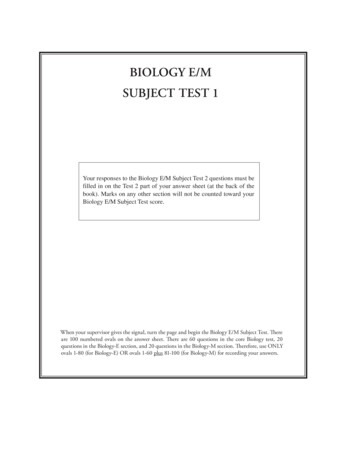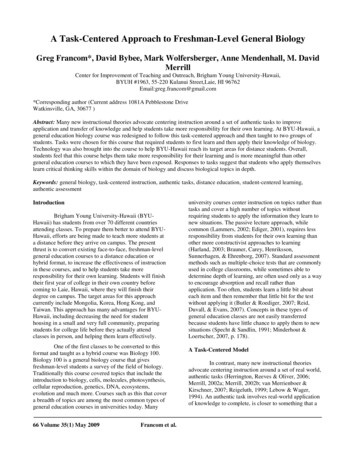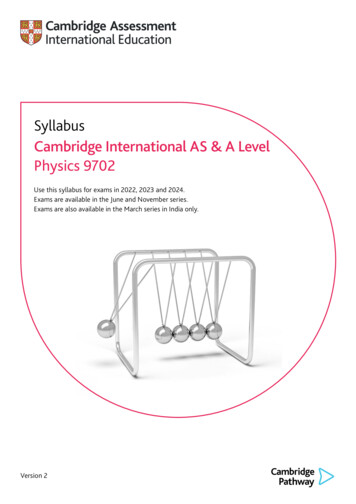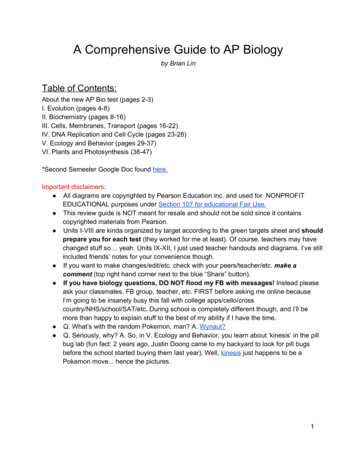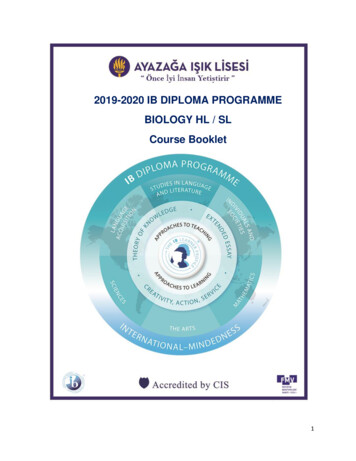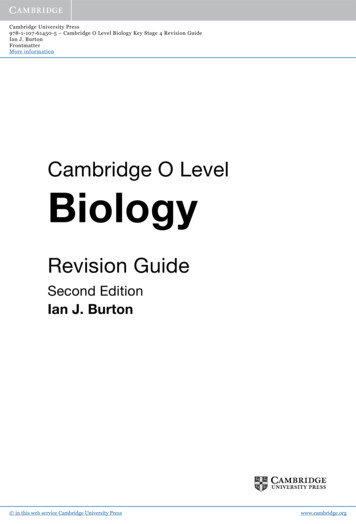
Transcription
Cambridge University Press978-1-107-61450-5 – Cambridge O Level Biology Key Stage 4 Revision GuideIan J. BurtonFrontmatterMore informationCambridge O LevelBiologyRevision GuideSecond EditionIan J. Burton in this web service Cambridge University Presswww.cambridge.org
Cambridge University Press978-1-107-61450-5 – Cambridge O Level Biology Key Stage 4 Revision GuideIan J. BurtonFrontmatterMore informationUniversity Printing House, Cambridge CB2 8BS, United KingdomCambridge University Press is part of the University of Cambridge.It furthers the University’s mission by disseminating knowledge in the pursuit ofeducation, learning and research at the highest international levels of excellence.www.cambridge.org Cambridge University Press 2000, 2015This publication is in copyright. Subject to statutory exception and to the provisions ofrelevant collective licensing agreements, no reproduction of any part may take place withoutthe written permission of Cambridge University Press.First published 2000Printed by Multivista Global Ltd, IndiaA catalogue record for this publication is available from the British LibraryISBN 978-1-107-61450-5 PaperbackCambridge University Press has no responsibility for the persistence or accuracyof URLs for external or third-party internet websites referred to in this publication,and does not guarantee that any content on such websites is, or will remain, accurateor appropriate. Information regarding prices, travel timetables, and other factualinformation given in this work is correct at the time of first printing but CambridgeUniversity Press does not guarantee the accuracy of such information thereafter.NOTICE TO TEACHERS IN THE UKIt is illegal to reproduce any part of this work in material form (including photocopyingand electronic storage) except under the following circumstances:(i) where you are abiding by a licence granted to your school or institution by theCopyright Licensing Agency;(ii) where no such licence exists, or where you wish to exceed the terms of a licence,and you have gained the written permission of Cambridge University Press;(iii) where you are allowed to reproduce without permission under the provisionsof Chapter 3 of the Copyright, Designs and Patents Act 1988, which covers, forexample, the reproduction of short passages within certain types of educationalanthology and reproduction for the purposes of setting examination questions.NOTICE TO TEACHERSTeachers and students are reminded of the importance of safe laboratory practice and, whileevery care has been taken to ensure that all experiments and demonstrations appearing in thetext are safe for both teachers and students to carry out, it must remain the responsibility ofthe teacher to ensure safe laboratory practice at all times and neither CUP nor the author acceptresponsibility for personal injury sustained while conducting procedures described in the text.Exam question sections at the end of each chapter include questions from past Cambridgeexam papers and other exam-style questions written by the author. Cambridge examquestions are reproduced by permission of Cambridge International Examinations. Answersto all exam questions are written by the author. Cambridge International Examinations bearsno responsibility for the example answers to questions taken from its past question paperswhich are contained in this publication. in this web service Cambridge University Presswww.cambridge.org
Cambridge University Press978-1-107-61450-5 – Cambridge O Level Biology Key Stage 4 Revision GuideIan J. BurtonFrontmatterMore informationTable of ContentsHow to use this bookivRevision GuidelinesviAcknowledgementsxChapter 1 Cell Biology1Cell structure and organisation1Movement in and out of cells9Enzymes17Chapter 2 Nutrition27Plant nutrition27Animal nutrition39Chapter 3 Transport59Transport in flowering plants59Transport in human beings62Chapter 4 Life ordination and response93Support, movement and locomotionChapter 5 Drugs, Microorganisms and the Environment101109The use and abuse of drugs109Microorganisms and biotechnology112The relationships of organisms with each otherand the environment117Chapter 6 Development of Organisms and the Continuity of Life133Reproduction133Inheritance153Answers to Questions172Glossary183Index195iii in this web service Cambridge University Presswww.cambridge.org
Cambridge University PressMineral nutrition in a plant978-1-107-61450-5 – Cambridge O Level Biology Key Stage 4 Revision GuideIan J. BurtonFrontmatter The importance of nitrogen-containing ionsMore informationLiving organisms need proteins for growth and repair. Plants have tomanufacture (synthesise) their own proteins and this they do by convertingtheir carbohydrates first into amino acids and then linking the amino acidstogether to form proteins.APTERCHThe additional element necessary to convert carbohydrate into amino acid isnitrogen and although the atmosphere is 79% nitrogen, plants cannot makedirect use of it. The nitrogen used by a plant is absorbed from the soil as the–nitrate ion (NO3) via the root hairs.How to use this book3 TransportThe importance of magnesium ionsAs with nitrates and all other ions, magnesium ions are also absorbed fromthe soilthrough thearerootmovedhairs. Magnesiumis the centralatom inHerea chlorophyllChemicalsaround livingorganisms.theremolecule.is a description of the movement of water, ions, sugars andamino acids within a plant (involving transpiration andtranslocation).This is followed by a description of the humanAnimal nutritioncirculatory system and of the constituents of blood.Introduction – sets the scene ofeach chapter, helps with navigationthrough the book and gives areminder of what’s important abouteach topic.fats and proteins are the three main classes of foods. Theirdered, as well Carbohydrates,as the importancechemicalstructuresare described here.living matter.Variousin floweringTransportplantsnoTegether with the adaptationsThe transportsystem of a flowering plant has to provide a means of carryingCarbohydratesrform waterdifferentfunctions.It will help you toand ionsfromroots tochemicalsthe leaves,containingand of carryingand carbon,amino hydrogenThesearetheorganicthe sugarselementschemicalsaredescribed,asisremember what is carriedImportant terms – clear andacids from theto only.otherThpartsof thewhileit is photosynthesising,andleavesoxygene ratioof plantatomsof hydrogento atoms of oxygen in ain the xylem and phloemstraightforward explanations aremicals releasedby fromcells.and, if necessary,storageorgansto the 2:1leaveswhenit isnot. Althoughcarbohydratemoleculeis always(as inwater– hencecarbohydrate).if you think of the threeglucose is the sugar made during photosynthesis, it is usually rapidly convertedconsecutive letters of theprovided for the cogento starch andstored – first within thelargechloroplasts.it is asthenmovedtheare insolublealphabet ‘W, X and Y’, words in each topic.(a starch‘solution’iniswhichin factforma starchsuspension).plant, it is changedto sucroseit is conductedthrough the phloem standing for Water in the– usually to beconvertedback to starchwhen areit reachesthestorageXylem. Phloem carries ans.as:e one cell only.plant’s food substancesVascular bundles contain the tissues for transport – xylem for carrying waterand amino acidsì complex sugars, such as maltose and sucrose (table sugar),sugarall withand ions and phloem for carrying sugar (sucrose) and amino acids.Phloemcarries the plants(the formula C12H22O11, orPhood!).simplesugars,acidssucharoundas glucoseor fructose,with the formula C6H12O6.and aminoa plantis called translocation.nisms. The movement ofìsugarnoteimportantThe positions occupied by xylem and phloem in the vascular bundles of roots,multicellular.Fats(or oils andif theyare liquid Notesat 20 C)– quick suggestions to remind you about key facts and highlightThe incytoplasmthestems and leavesa typical dicotyledonousplant are shown in Figure 3.1.These, too, are organic chemicals which contain the elements carbon,important points.nucleus make up thehydrogen and oxygen only. This time, however, the ratio of H to O in theprotoplasm.nto and out ofater. All otherxylemules are unabley permeable.phloemA stem in crosssectionA root in crosssectionnoteDNA stands fordeoxyribonucleic acid.9781107614505 Biology Ch 2.indd 39teactionsofvascularthebundlee nucleus.wise to collectmadeof oftheerenttypesyou begin, sinceesponsibleforbetterthaneins.ng which eachlls formed are781107614505 Biology Ch 3.inddA leaf in sectionNutrition 39upper surface22/05/15 7:26 AMxylemphloemFold a leaf (e.g., Lantana)phloem in half, so its upper surface comesintocontactwithitself,then tear the leaf along its fold. Withxylem x*practice, you should be able to leave a thin, transparent piecenoteof lowerepidermissiderootof thefold. Carefully removeFigure 3.1The positionof xylem andalongphloemonein a stem,and leaf*(A memory aid: ‘x’ for xylem marks the centre of a circle.)this and transfer it to a drop of water on a microscope slide.Plant cells undergoingcelllower a cover slip onto the specimen, and using low 59Gentlydivision do not havepower on your microscope, identify the guard cells. You maya vacuole.need a higher power to see the chloroplasts within the guard 25/05/1559cells.11:28 AMnoteTask boxes – check your own knowledge and see how well you’re getting on by answeringap (and, thus, regularCelluloseis a tough,and doing activities.questionsTo demonstrate the presence of stomata, submerge a leaf ininsoluble carbohydrate.ly of sugars. Ita beaker of hot water, and watch as air bubbles form over thee.Biologyas the air in the intercellular spaces expands andiv Cambridge O Levelstomatapasses out of the leaf.1How a leaf is involved in the process of photosynthesis in this web service Cambridge University Press1. Carbon dioxide diffuses down a concentration gradient from thewww.cambridge.org
Cambridge University Press978-1-107-61450-5 – Cambridge O Level Biology Key Stage 4 Revision GuideIan J. BurtonFrontmatterMore informationAim:Apparatus:Method:To show that light is necessary for photosynthesisthe productschemical molecule a well-watered,de-starched,potted plant (for example, Pelargonium or Coleus)(the substrateor ‘key’) a cork cut into two piecessunlight for a pin8 hoursThe apparatusis set up as shown inactivesiteFigure 2.2. The cork is fixed in the eveningpinso that the leaf has time to destarch overcorknight.enzyme (the ‘lock’)The experiment is left in sunlight for 8and key’ hypothesis of enzyme actionhours. FigureThe 1.17corkTheis‘lockremovedfrom the leaf, well-wateredpottedand theexplainsstarch enzymetest is carriedout on the leaf. PelargoniumThe ‘lock and key’ hypothesisaction because:1.Results:Only the correct enzyme substratecan work.Where the corkcombinationcovered theleaf,the leaf2. Increased temperaturethe stainedmolecules of Figure 2.2 Experiment to show that light isstainedincreasesbrown.theThratese restatofwhichthe leafenzyme and atenecessary for photosynthesisblue/black.molecules enter and product molecules leave the active site of the enzyme.Onlyhad beenabletotoreachthe leaf had starch been made; thus, light is3.Conclusion:Extreme heat causesthewhereatoms oflightthe enzymemoleculemoveso violentlyfor tophotosynthesis.that they change necessaryposition relativeone another thus changing the shapeof the active site so the enzyme stops doing its job.4. Changes in pH are known to alter the shape of large molecules like proteins.Practical– reinforceyourandpracticalknowledgeskills with clear explanations and diagrams.Whenskillsthat proteinan enzyme,as the shapeof theactiveandsite changes,Aim:Tois showthat chlorophyllis necessaryfor photosynthesisthe enzyme will work less efficiently.Apparatus: a well-watered, de-starched, variegated, potted plant (for example, Pelargoniumor Coleus)Points toPoints to remember – at the end ofrebmremeNote:A variegated plant haseach chapteryoutestcan check off theBefore starch testAftersostarchleavesandwhichare greenbrown(no starchì Know the similaritiesdifferencesbetween plant and animal cells.topics as yourevisethem.present)white (no chlorophyll)wherechlorophyllisì Know the difference between tissue, organ and organ system and beable to define each.present, and whiteì Be able to definediffusionwhereand osmosis.(usually)there isì Learn what is meantby active transport.no chlorophyll.ì Be able to write down definitions of the following terms:greenMethod:Leavewaterthepotential,plant partiallyinplasmolysis, turgor,permeable(containingblue/blackmembrane. sunlight for 8 hours, chlorophyll)(starch present)after which remove oneFigure 2.3 Experiment to show that chlorophyll is necessaryleaf and carry out thefor photosynthesisCell Biology 21starch test on it.questionsforyou toareatrystains brown (no starch present); the green areaResults: Exam-style(See Figure2.3.) The 2/05/15 6:59 AM9781107614505 Biology Ch 1.indd 21stains blue/black (starch present).A. A blood cell passes through the heart twice in one complete circulation.B. Bloodtravelsstarchtwice roundthe bodybeforebeing pumpedthe lungs. there was chlorophyll, chlorophyll isConclusion:Sincehasbeenmadeonly towhereC. The heart contains two different types of valve.necessaryfor photosynthesis.Exam-style questions– thoroughlyprepare for examinations by completing the exam-style questions andD. There are two types of chambers in the heart, atria and ventricles.checking youranswerswhicharethroughprovidedat(viewedthe backtheWhichbook.2. Figure3.11 showsa sectionthe heartfrom theoffront).valve closesin order to ensure that blood flows to the lungs?B9781107614505 Biology Ch 2.indd 29A in this web service Cambridge University PressCDNutrition 29Cambridge O Level Biology v22/05/15 7:01 AMwww.cambridge.org
Cambridge University Press978-1-107-61450-5 – Cambridge O Level Biology Key Stage 4 Revision GuideIan J. BurtonFrontmatterMore informationRevision GuidelinesUnderstanding Biology at Cambridge O Level is not usually a problem, but committing facts to memorycan often be a major obstacle to success. Many students are at a loss to know exactly how to set about whatseems to them to be a task of immense proportions. I offer the following method, one which I devisedmyself when, as a student, I was faced with the same problem. It has the advantage, if followed carefully, ofimproving one’s factual knowledge as a result of time spent, rather than of any specific effort to learn.All important words, terms and phrases in the text of this book have been written in bold and italics. Thegreater the amount of material thus presented in the text that is committed to memory, then the greater thechances of success in examination. The method which I offer for learning it is as follows:1.Take a sheet of file paper and divide it with a vertical line such that three quarters of the sheet is on theleft of the line.2.Read a page of the Revision Text, and each time you come to a word or phrase which appears in bold anditalics, then construct a simple question to which that word or phrase is the answer.3.Write these simple questions on the left-hand side of your sheet of file paper, leaving a space betweeneach, and number them. Continue on further sheets of paper if necessary.4.If there is a diagram in the text, then draw a quick sketch of the diagram on the left-hand side of yoursheet with numbered label lines above each other extended towards the right-hand side of your sheet.5.When you have reached the bottom of the page of text, close the book and see how many of the answersyou can write down on the right-hand side of your sheet. When you have attempted all answers, checkthem against the text. You will probably be surprised at how well you do, but since you wrote thequestions, carefully phrased around the required answer, perhaps it is not so surprising after all.6.Continue until you have a list of questions and answers to the section you are trying to learn.7.Take a second sheet of paper (folded if writing would otherwise show through it), and use this to coverthe answers. Test yourself again, writing your answers on the folded sheet, and continue this until youare able to score over 80%. (You can, of course, set your own target. Some will not be content until theycan score 100%.)8.File away your Question/Answer sheet for further revision at a later date.9.Continue this process systematically, until you have, effectively, a full set of revision notes for later use.10. In the last few weeks before an examination, it is better to revise by reading the text of this bookcarefully, a chapter at a time. Concentrate on every sentence, making sure you understand what youhave read. It is so easy to get to the bottom of a page in a book, and realise that your mind was elsewhereas you were reading it, and as a result, nothing registered at all. If that happens, be honest with yourself.Go back to the top of the page and start again.11. In the last few days before examination, your Question/Answer sheets should now prove invaluable forlast-minute consolidation of your facts.It cannot be stressed too strongly that examination results depend on knowledge. It is important that youhave a very good grasp of simple knowledge to do well and interpretation questions often rely heavily on asound knowledge of the subject matter.vi in this web service Cambridge University Presswww.cambridge.org
Cambridge University Press978-1-107-61450-5 – Cambridge O Level Biology Key Stage 4 Revision GuideIan J. BurtonFrontmatterMore informationThe advantage of this revision method is based so firmly on the student phrasing the questions to whichhe or she will already know the answer that it would defeat the object if more than a short example of thetechnique were given. The success of the method relies only on the student following the technique carefully.It does work, but you must be prepared to spend the necessary time. You may even enjoy the experience!ExampleExample of a Revision Sheet, based on the beginning of Chapter 1 in this Revision Guide (Cell Biology), isshown here.1. What word is used for organisms containing only one cell?unicellular2. Give an example of a one-celled organism.a bacterium3. What word is used for organisms made of many cells?multicellular4. What structure controls the passage of substances into and out of a cell?cell membrane5. In what state must all chemicals be before they can enter or leave a cell?in solution6. What is the jelly-like substance where chemical reactions occur in a cell?cytoplasm7. What is the correct term for the chemical reactions in a cell?metabolic reactions8. Whereabouts in a cell are chromosomes found?the nucleus9. What do chromosomes contain?genes10. Of what chemical are chromosomes made?DNA11. What makes up protoplasm?cytoplasm nucleus12. What is the space in the centre of a plant cell?vacuole13. What does this space contain?cell sap14. What is the name of the box in which a plant cell is contained?cell wall15. What chemical is this box made of?cellulose16. Name the green structures in photosynthesising cells.chloroplasts17. What pigment do they contain?chlorophyllCambridge O Level Biology vii in this web service Cambridge University Presswww.cambridge.org
Cambridge University Press978-1-107-61450-5 – Cambridge O Level Biology Key Stage 4 Revision GuideIan J. BurtonFrontmatterMore information18–23. Add the labels to the diagram.cell wallcell membranecytoplasmchloroplastvacuolenucleusIn addition to producing a revision sheet, it will help to commit facts and concepts to memory if, whilestudying a topic, you stop occasionally to discuss or to solve a related problem. Biology is a subject thatencourages a student to conduct investigations to supplement their knowledge and understanding.Throughout this text, there are ‘task boxes’ indicated by a tick ( ) to the left of a pencil point. The tasks fallinto three categories: category 1 is a simple mental task that will allow you to see whether you understandthe topic under consideration. If you are unable to answer any question asked in the task box, you mayconsider discussing it in a small group, arriving at an answer and then checking, either with a text bookor teacher, to see whether you are correct. Categories 2 and 3 will help to supplement you knowledge ofa topic. Category 2 is in the form of a simple practical exercise that can be carried out on your own, whilecategory 3 may be more suited to a practical investigation that might be carried out as a class exercise ordemonstration.Some hints on how to draw biological specimensDrawing specimens is not an exercise in artistic ability; it is an exercise in observation. Your drawingsshould therefore show the features that you have observed.ì Your drawings should be as large as the paper you are drawing on will allow.ì They should be made using a sharp, preferably HB, pencil.viii Cambridge O Level Biology in this web service Cambridge University Presswww.cambridge.org
Cambridge University Press978-1-107-61450-5 – Cambridge O Level Biology Key Stage 4 Revision GuideIan J. BurtonFrontmatterMore informationì They should have sharp outlines (not ‘sketchy’ ones).ì They should have the same proportions as the specimen you are drawing.If the anther is, say, three times wider than but only one-sixth as long as thefilament, it should be drawn as such. Measure the specimen before you beginand make very faint marks on your paper to guide you. (They can be carefullyerased afterwards.)ì If there is a clear point of structural detail in the specimen – e.g., nectarguides on the petal – the same points should be shown on your drawing, inthe correct place. (If they are a large number of similar such points, only a fewneed be drawn.)ì Avoid shading. If an area is darker than the rest of the specimen, draw anoutline of the area and label it.ì Rule label lines in pencil and label in pencil preferably in capital letters(pencil can be rubbed out and corrected, and capitals are usually easier toread). Label lines should terminate exactly at the point being labelled.ì Avoid arrowheads on your labels – they can obscure an important featurebeneath them.ì Always give a magnification to your drawing. It is a linear magnification,i.e. calculated by measuring the length or width of the specimen, and thelength or width of your drawing measured across the same structural feature.length of drawinglength of specimennoteWhen drawing from aphotograph, there issometimes a magnificationgiven for the photograph.In such cases, you mustmultiply the magnificationof your drawing by thisfigure. magnification (expressed as, e.g., ‘ 4.5’)It would not normally be the case that your drawing or measurements would beaccurate enough to give a magnification to more than one decimal place. Do not‘round off ’ too much. 4.6 is not 5.As an examination approaches and a greater amount of time is spent on revision,it is usually more productive to set aside a certain time each day for revision. Donot allow yourself to be persuaded to do anything else during that time.Work on your own with no distractions around you. Some people say they canwork better listening to music. If that really is so in your case, then keep themusic quiet, and, at least, it may shut out other distractions!You may find it helpful to make a calendar by dividing a piece of paper into aspace for each day during your revision period before any examination. Thenyou can divide the syllabus into the same number of parts as there are days forrevision, and enter one such part per day on your calendar. In this way you willknow exactly what you are going to revise on each day. Your day’s revision willnot be complete until you have revised everything on your calendar for that day.People vary as to how long they can work at a stretch. It is important to have a breakfrom time to time (again, preferably, the same time each day). When you stop, setyourself a time to resume your revision, and stick to it.Finally, good luck with your revision. This method can work. I know, because itdid so for me!Ian J. BurtonCambridge O Level Biology ix in this web service Cambridge University Presswww.cambridge.org
Cambridge University Press978-1-107-61450-5 – Cambridge O Level Biology Key Stage 4 Revision GuideIan J. BurtonFrontmatterMore informationAcknowledgementsEvery effort has been made to trace the owners of copyright material included in this book. The publisherswould be grateful for any omissions brought to their notice for acknowledgement in future editions of thebook.Syllabus Name & CodePaper & Question NumberMonth/YearChapter/Pagein BookCambridge O Level Biology 5090Paper 22, Q1November 2011Chapter 1, P 25Cambridge O Level Biology 5090Paper 21, Q8November 2010Chapter 1, P 26Cambridge O Level Biology 5090Paper 22, Q2June 2011Chapter 2, P 57Cambridge O Level Biology 5090Paper 22, Q6November 2011Chapter 2, P 58Cambridge O Level Biology 5090Paper 22, Q7November 2011Chapter 3, P 76Cambridge O Level Biology 5090Paper 02, Q3June 2008Chapter 5, P 126Cambridge O Level Biology 5090Paper 22, Q8June 2011Chapter 5, P 126Cambridge O Level Biology 5090Paper 2, Q1June 2007Chapter 6, P 164Reproduced by Permission of Cambridge International Examinations. Cambridge InternationalExaminations bears no responsibility for the example answers to questions taken from its past questionpapers which are contained in this publication.The authors and publishers acknowledge the following sources of copyright material and are grateful forthe permissions granted.Cover Mehau Kulyk/SPL; p. 3 Marshall Sklar/SPL; p. 4 Kevin & Betty Collins, Visuals Unlimited/SPL; p. 5Dr. Robert Calentine, Visuals Unlimited/SPL; p. 6 Dr David Furness, Keele University/SPL; p. 8 MelbaPhoto Agency/Alamy; p. 35 Jubal Harshaw/Shutterstock; p. 35 Dr Keith Wheeler/SPL; p. 137 Dr JeremyBurgess/SPL; p. 138 Susumu Nishinaga/SPLSPL Science Photo Libraryx Cambridge O Level Biology in this web service Cambridge University Presswww.cambridge.org
9781107614505_Biology_Ch_3.indd 59 25/05/15 11:28 AM 38 Cambridge O Level Biology Revision Guide Fold a leaf (e.g., Lantana) in half, so its upper surface comes into contact with itself, then tear the leaf along its fold. With practice, you should be able to leave a thin, transpa





